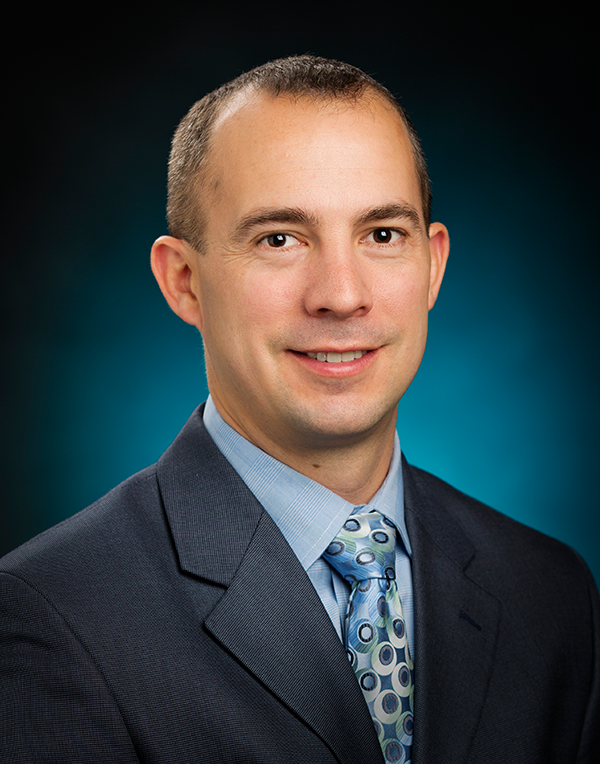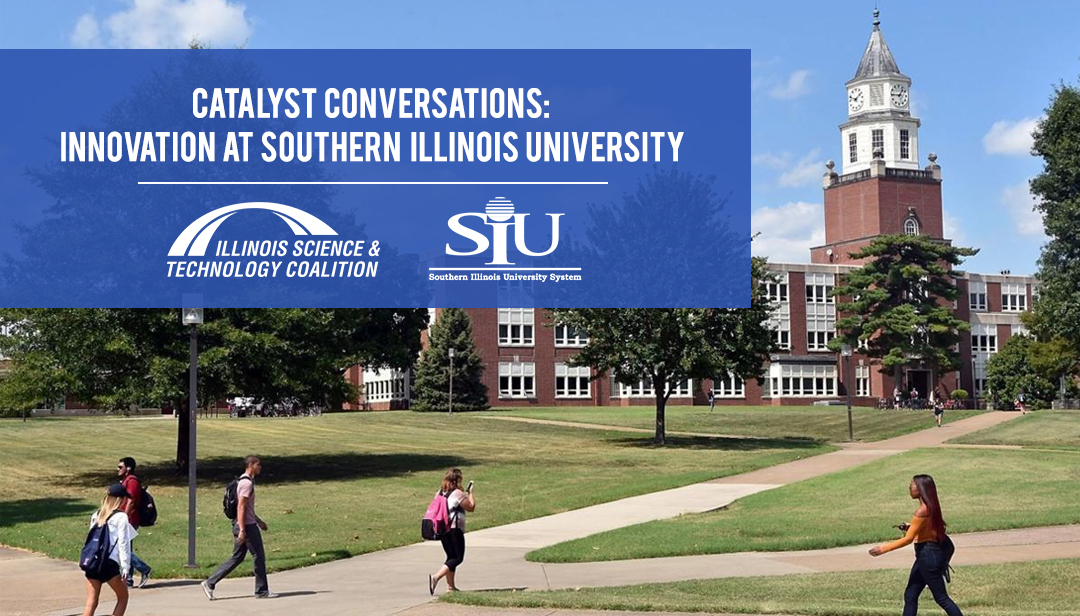Illinois’ universities are regional economic hubs—attracting talent, conducting research and development activity, and fostering entrepreneurship that leads to the creation of strong jobs. In this Catalyst Conversations, we hear from Robert Patino, JD, Director of Office of Technology Transfer at Southern Illinois University about driving innovation and economic growth in southern Illinois, the university’s new Research Enabled platform that’s connecting its researchers to the challenges of industry, and much more.
Subscribe to get the Catalyst newsletter sent to your inbox.
I am the Director of Technology Transfer at the SIU System. In this capacity, I oversee the Office that is responsible for managing the intellectual property assets of the university. Our Office helps with the intellectual property needs of the sponsored research and clinical trials we perform; but more importantly, our Office helps make new ideas and discoveries available to the public via the commercialization process. To effect the commercialization process, we must protect these new ideas and discoveries with intellectual property assets and transfer them to 3rd party for monetizing the value of those assets as the university is not in the business of commercializing products or services. This process helps grow the economic prosperity of the communities that we serve by assisting with the creation of new enterprises through startup company endeavors or by developing new products or service lines for established companies. The mission of our Office is to help make our community and world a better place by making innovation available to industry partners to make those products and services available to the public.
2. What are some of the innovation and/or commercialization initiatives that SIU is focusing on across its three campuses? What role do these SIU initiatives play in driving economic growth in southern and central Illinois?
Each campus has their own unique strengths as it relates to technology development and transfer and the communities they serve have unique needs and resources available to them. For example, our Carbondale campus has a historically strong research tradition but it is more isolated from larger urban centers. Its strengths reside in agriculture, engineering, material science and imaging, just to name a few. Our Edwardsville campus has strong urban assets available due to its proximity to St. Louis and a growing, yet more nascent, research program. Its strengths lie in pharmaceuticals, dentistry, engineering and computer science. Our Springfield campus is primarily focused on medicine due to the presence of the School of Medicine. Its strengths reside in research tools, medical devices, diagnostics and therapeutics.
Our Office helps the campuses in various ways. One role is to educate our faculty on the innovation commercialization process because if this process is not adhered to properly, we may not be able to secure the appropriate intellectual property asset for that discovery. Furthermore, our role is to serve as a resource and assist in finding research assets or development partners within the SIU System or outside of the SIU System. It is not unusual that a physician might need an engineer or material scientist to help out with a medical device or a scientist with a new therapeutic might need a delivery mechanism, and we can help our faculty find those resources. Moreover, our role is to help find resources such as investment capital or new industrial partnerships that might not otherwise be readily available to the university campuses. These efforts help with the development of intellectual property assets which in turn, help grow the economy of southern and central Illinois by increasing sponsored research activity, adding new companies in the region and returning revenue back to the university in the form of royalties.
3. An increasingly important component for universities driving innovation is collaborating with industry. With that in mind, you’ve built Research Enabled, a platform that helps industry engage with university researchers. What gap did you identify that led to the decision to build the platform?
First, the traditional technology transfer model is inefficient. Often technology transfer managers work with faculty to secure new technology that may or may not be ready for the marketplace. We advertise and solicit companies to adopt our technology, “pushing” our technologies to be adopted but the technology may not fit neatly in a product line or the value proposition is unclear because the technology is so nascent. Secondly, government research dollars have been flat and it is increasingly difficult to access those dollars as the number of research institutions and researchers added to that competitive field have only increased. Universities are struggling to increase their research funding and need to look to industry for continued growth in research funding. It is important to bring industry dollars into the region or keep those dollars here if local industry partners are looking for academic collaborators. Thirdly, the critical mass of researchers at the Southern Illinois University is strong, but not nearly as strong tier one research institutions. Research Enabled solves these challenges by (1) allowing industry partners to communicate their needs to help enable a “pulling” effect on technology developed within the SIU System by more deliberately addressing those needs, (2) increasing the research dollars available to the SIU System by more efficiently dealing with industry partners and (3) allowing the SIU System to pool its research capacity with other partners such as the University of Missouri System to create a critical mass of researchers that would be more attractive to industry to leverage.

Robert Patino, Southern Illinois University
Research Enabled is a platform that allows industry to efficiently work with university researchers or leverage their internal assets. Most industry partners need to investigate a university, attempt to identify faculty or staff that can assist them with their research needs and then approach the university and the faculty member to make that relationship. On the Research Enabled platform, an industry partner is allow to communicate their research need through a “Research Challenge”. The Research Challenge can be sent to a range of researchers as broadly or narrowly as the industry partner wants. For example, an industry partner looking for research assistance on a fuel cell membrane may simply input “engineering” + all campuses or narrow their search further by inputting “engineering+fuel cell+solid oxide” + SIU Carbondale. An email will go to all of the investigators that meet that search criteria with the Research Challenge. The investigators can reply to the Research Challenge with their own unique proposal or proposals and list their assets. Those proposals get consolidated and sent back to the industry partner and the industry partner selects the proposal it likes best. The advantages of this method are that the company only receives proposals from investigators that are interested in working with them, there is an opportunity to get “out of the box” thinking by broadening a search, and junior faculty have an opportunity to establish relationships with industry partners that they might not otherwise have. Furthermore, the process is streamlined since the needed contracts are already pre-approved by the Legal Department of the university making for a more frictionless process if the industry partner chooses to use those forms.
The Research Enabled platform has other features and tools as well. It can help startup companies find faculty collaborators to help apply for SBIR/STTR or other foundation grants that are available. There are other features within the platform that are geared to help industry find research tools such as imaging equipment, testing apparatuses or other equipment that might not be readily available to the industry partner. And finally, the platform can help researchers find other collaborators by matching the needs of an investigator with the abilities of other researchers on the platform.
5. With the Research Enabled platform now up and running, connecting industry innovators with university researchers, what’s next? What does success look like for Research Enabled five or ten years in the future?
This is a terrific question! Research Enabled was founded by a collaborative effort with the Southern Illinois University System and the University of Missouri System with the help of the Economic Development Administration (EDA) funding through the Department of Commerce. The Research Enabled platform has enormous potential as validated by our industry partners in the regional community; however, growing the platform outside of our established region of Missouri and central and southern Illinois requires the recruitment of more partners on both the academic and industry side. Adoption of the platform will be critical to its growth and success. The SIU System is now engaged with the Illinois Science and Technology Coalition to grow the platform strategically in Illinois to better capture the opportunities in northern Illinois. We also continue to get interest from academic and industry partners outside of Missouri and Illinois and the platform will have to grow in a more thoughtful manner to determine its service mission regionally from an academic perspective and globally in terms of bringing in more industry partners. So what does Research Enabled look like five to ten years from now? It is my hope that it becomes a vibrant and independent not-for-profit entity that becomes the “go-to” shop for industry partners looking for research assistance in all fields, not just STEM areas of interest. Furthermore, it is my hope that academic collaborators will use the platform to locate research collaborators across disciplines and across campuses. And most importantly, I hope that the platform will help transform “fly over country” into a “let’s see what we can find here in the Midwest” destination as it relates to our research enterprise needs and give some of our underdog institutions and junior faculty a competitive chance in developing a new relationship with an industry partner.

